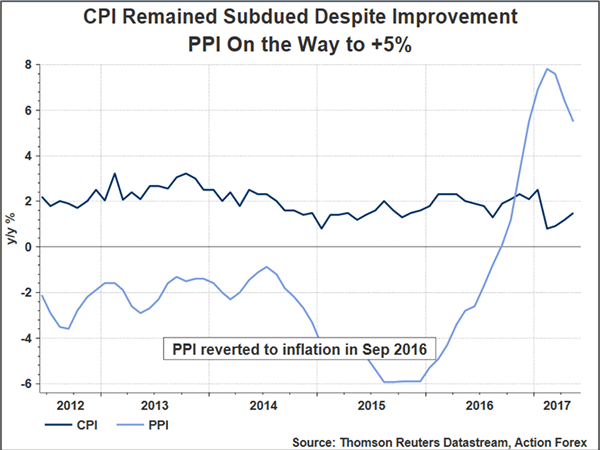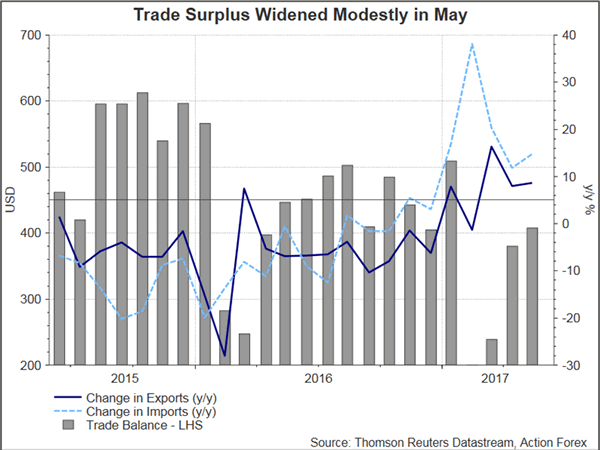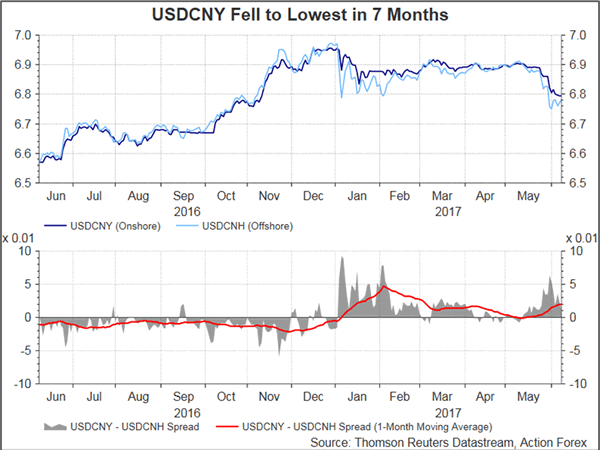China’s headline CPI inflation accelerated to +1.5% y/y in May, from +1.2% a month ago. for the first 5 months of the year, CPI has stayed at average of +1.4%, amongst the lowest levels in history. Core inflation steadied at +2.1% in May. Non-food CPI moderated to +2.3% from 2.4% in April. Food inflation remained in contraction but the decline narrowed to -1.6% y/y in May from -3.5% in the prior month. We believe it was the low base that had helped improve the reading. PPI inflation continued to slow, falling to +5.5% y/y in May from +6.4% in April. Weakness in commodity prices is expected to weigh on PPI, sending it lower to around +5% in coming months.

Trade
Both of China’s exports and imports growth exceeded expectations in May. Exports growth accelerated to +8%y/y from +8.7% a month ago, thanks to the strong increase in shipment to the EU and, to a lesser extent, South Korea. Notwithstanding the high base the same period last year, imports growth accelerated to +14.8% y/y from +11.9% in April. G3 imports surged +15.6% in May, up from +3.6% y/y a month ago. Meanwhile, imports from the US jumped +27% y/y last month, compared with April’s +1.5% growth. The country’s trade surplus widened to US 40.8B in May, from +US$ 38.1B in the prior month. Indeed, we mentioned in our previous report that the widening gap between exports and imports in the official manufacturing PMI report signaled stabilization in China’s trade balance.
Looking into commodity sector, China imported 8.8M bpd of crude oil in May, up 4.6% m/m and 15.4% y/y. The country’s imports were mostly heavier, sweet West African grades. Net exports for preliminary petroleum product increased to 401M bpd in May, up +40.8% from the prior month. From a year ago, net exports of which soared +73.9%.

FX Reserve
Separately, PBOC’s FX reserve increased +US$ 24B to US$ 3.054 trillion, highest in 7 months, in May. This beat expectations of a +US$ 16B increase. The reading remains largely unchanged after adjusting for currency valuation effects. China returned to FX accumulation over the past few months as it faces less pressure on renminbi depreciation, thanks to its stringent capital control measures and Weakness in Us dollar. Note that USD tumbled to a seven-month low in recent weeks and sank -2.5% in May. We expect to see less aggressive sale of FX reserve for supporting renminbi in the futures as China has decided to add a “counter cyclical adjustment factor (CCAF)” to calculate renminbi. While such “factor” might lower the volatility of renminbi, its ambiguity would only make the movement of currency even less transparent.
















